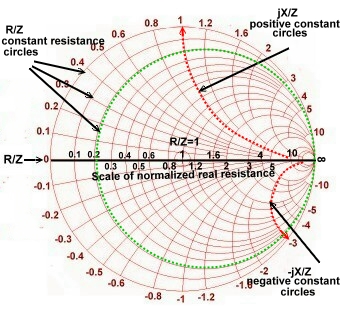

Also note that the input stability circle represents a boundary, on one side of which |Γ IN| IN| > 1, corresponding to load impedances that produce potential instability.

The input stability circle represents a set of load reflection coefficients that cause the input reflection coefficient to have a unity magnitude. The contour of values for Γ L (also a circle) that produces a unity magnitude reflection coefficient at the input is called the input stability circle (shown in Fig. The boundary line between stable and unstable operation at the input is the |Γ IN| = 1 circle centered at the origin of the Smith Chart. If either or both of these conditions can occur at any frequency, the circuit is said to be only conditionally stable, or equivalently, potentially unstable. Similarly, certain values of source reflection coefficient, Γ S, at the input might cause the output reflection coefficient, Γ OUT, to exceed unity magnitude. It is possible that for certain values of load reflection coefficient, Γ L, the input reflection coefficient, Γ IN, can exceed unity, turning the circuit into a reflection amplifier at the input. A properly designed (stabilized) amplifier will not oscillate no matter what passive source and load impedances are presented to it, including short or open circuits of any phase.īecause the value of S 12 for practical transistors is not zero, a signal path exists from the output (where power levels are higher due to the device's gain) to the input ( Fig. However, this is not considered unconditional stability, because with different source and load impedances the amplifier might break into oscillation. This means that the transistor is stable when embedded between 50-Ω source and load, and it will not oscillate. In the 2N6679A transistor amplifier example, the magnitudes of S 11 and S 22 of the transistor are less than one for all frequencies. This corresponds to reflection gain, and a transistor amplifier that can experience this gain, is termed conditionally unstable, the conditions being certain combination(s) of load impedance, S 12 and S 11 to produce self-oscillation (instability). When it does so, it may combine with reflections already present at the input to produce an effective S 11 whose magnitude exceeds unity. The S 12 parameter provides the feedback term by which power from the output circuit (which may be relatively high due to the transistor's amplification) can feed back to the input. Making the unilateral assumption is equivalent to assuming that S 12 is zero. Thus far, the transistor has been treated as a unilateral device, with signals assumed to pass from the input to the output but not in the reverse direction.
#STABILITY CIRCLES ON SMITH CHART HOW TO#
This second part of the article series will examine the stability of a transistor amplifier and how to apply stabilizing elements to obtain it. Additional gain could be obtained at any given frequency for which the transistor has gain by adding matching circuits at the input and/or at the output. As was shown last month in the first installment of this article series, in this simple case, the gain at each frequency was just the square of the magnitude of S 21 as listed in the S parameter table for the transistor. Amplifiers can be designed as simply as by installing a transistor in a 50-Ω system.


 0 kommentar(er)
0 kommentar(er)
